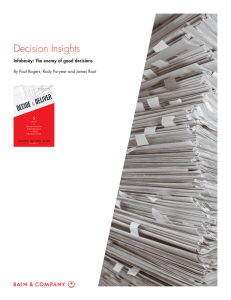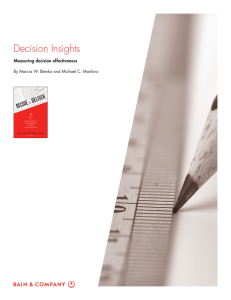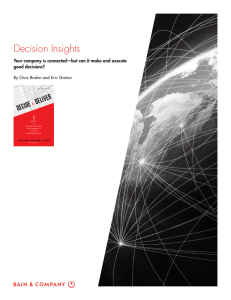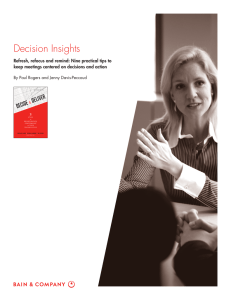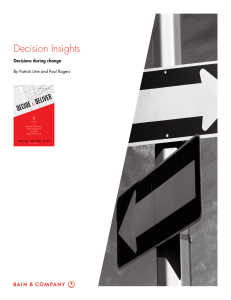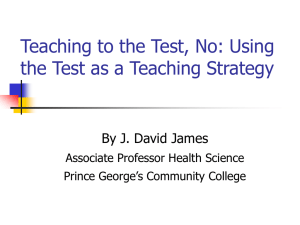Decision Insights 2.0 Decision diseases: The 10 common ailments that plague organizations
advertisement
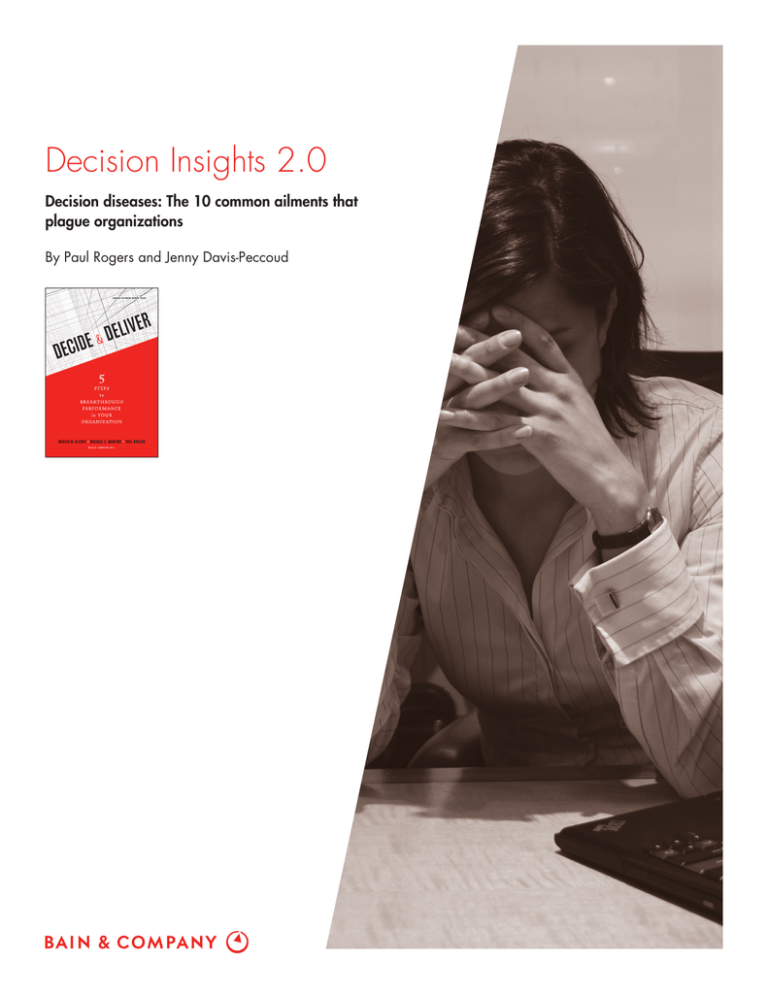
Decision Insights 2.0 Decision diseases: The 10 common ailments that plague organizations By Paul Rogers and Jenny Davis-Peccoud Decision diseases: The 10 common ailments that plague organizations Why can’t we ever make a simple decision 4. Structural sclerosis. The organization’s structure obstructs good decision making and execution. A without screwing it up? At many companies, this agonized cry reverberates from the CEO’s office to the front line. People know that too many key decisions turn out wrong, take too long or somehow never get translated into action. It’s one of the most common organizational complaints we hear. rental-car company in Europe was organized by country. How could it ever hope to offer seamless service to the highly profitable travelers who crossed country borders? 5. But decision failure is just a symptom. The best way to address it is to diagnose the underlying condition, so that you can take the right corrective action. Over the years, we have seen 10 common ailments in our work with organizations, and we have given them quasi-medical names to help clients recognize them. See if your company has contracted any of these debilitating decision diseases: 1. 2. 3. Blurred vision. At some organizations, people lack a context for making and executing key decisions. They don’t know what hill to take, let alone how to take it. Think of Reebok some years back. It diversified into fashion footwear and boats (not boat shoes, boats). It was the wrong move for the company at that time, leading to a tarnished brand and eroded market share. Split personality. There’s a vision, all right, but people understand it differently or else don’t buy in at all. A UK retailer developed an ambitious storeopening plan. But the various parts of the organization—buying, store design, operations and so on— each had a different idea on how to go about it. The result: stalled decisions and a sluggish rollout. Decision constipation. The organization strains, but nothing happens. An auto company’s European operations reached the brink of bankruptcy, and still its cars were uncompetitive and late to market. One reason: Global product development thought they had the final call on new-product features. Regional marketing thought they did, causing a decision blockage. Process paralysis. Business processes grind to a near-halt because no one scrutinizes them with key decisions in mind. One pharmaceutical product team struggled to perform critical analyses on drugs before a key stage gate. Finally—aha!—the organization realized that much of the detailed work could be restricted to only those drugs that made it through the stage gate. 6. Data dysfunction. The information needed for major decisions isn’t available at the right time or in the right format. Conversely, decision makers may be swamped with more data than they can possibly decipher and use. One major oil company provided senior managers with all kinds of metrics— but no one was sure which factors actually drove business success. 7. Misaligned incentives. Measures and incentives don’t reinforce good decisions. Look no farther than the 2008 Wall Street debacle: Many traders received outsized rewards for decisions that hurt their companies’ long-term value. 8. Talent deficiency. Positions that are central to key decisions aren’t held by people with the necessary experience and competencies. A struggling telecommunications company found that only 40% of its critical positions were filled by top talent, and only 30% of its best managers were in key jobs. Little wonder its performance was suffering. 9. Behavior breakdown. Leaders undermine effective decision making and execution, often unintentionally. The CEO of a large consumer-products company restructured the organization around a new global vision and mission. But many country-based general managers continued to operate just as they had before, putting local interests first. Decision diseases: The 10 common ailments that plague organizations 10. Culture collapse. The organization lacks a sense of identity and forward movement. Decisions disappear into a dysfunctional culture. In the late 1990s, the power technology and automation company ABB struggled with nearly every major decision, including bids on major jobs. ABB’s thousands of units pursued their own priorities and jostled with one another for advantage. Some managers had three, four, even five bosses, and had to get approval for major decisions from each one. Fortunately, all of these ailments can be addressed. The specifics naturally differ from one company to another. But the overall prescription is usually to open up the decision pathways, assign clear decision roles and then create an environment that supports great decision making and execution. Even a culture collapse, which might otherwise seem terminal, responds to comprehensive treatment. When Jürgen Dormann became CEO of ABB in 2002, he and his team consolidated ABB’s units into just two divisions, eliminated an entire management layer and centralized profit-and-loss accountability. They built a tight, cohesive leadership team aligned around a set of well-understood goals, clarified roles and spelled out exactly which decisions would be made by headquarters and which by the newly consolidated business units. By 2007, the company was fully back on track, its share price and market value up fivefold in just five years. For an indication of where your own company’s troubles might lie, begin by taking the diagnostic quiz at www.decide-deliver.com. For a full workup, you may want to make a thorough assessment of your organization’s strengths and weaknesses and then benchmark them against Bain’s database of more than 1,000 companies. Decision ailments are too important to let fester. Top companies maintain their decision systems at the peak of health—and their performance reflects it. Paul Rogers is the managing partner of Bain’s London office and leads Bain’s Global Organization practice. Jenny Davis-Peccoud is senior director of Bain’s Global Organization practice. She is based in London. Copyright © 2012 Bain & Company, Inc. All rights reserved. Content: Global Editorial Layout: Global Design Shared Ambit ion, True Results Bain & Company is the management consulting firm that the world’s business leaders come to when they want results. Bain advises clients on strategy, operations, technology, organization, private equity and mergers and acquisitions. We develop practical, customized insights that clients act on and transfer skills that make change stick. Founded in 1973, Bain has 47 offices in 30 countries, and our deep expertise and client roster cross every industry and economic sector. Our clients have outperformed the stock market 4 to 1. What sets us apart We believe a consulting firm should be more than an adviser. So we put ourselves in our clients’ shoes, selling outcomes, not projects. We align our incentives with our clients by linking our fees to their results and collaborate to unlock the full potential of their business. Our Results DeliverySM process builds our clients’ capabilities, and our True North values mean we do the right thing for our clients, people and communities—always. For more information, please visit www.decide-deliver.com For more information about Bain & Company, please visit www.bain.com



